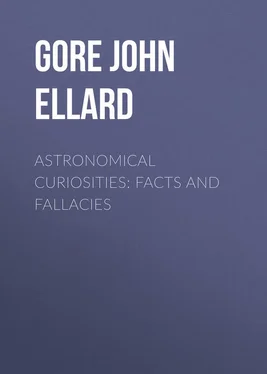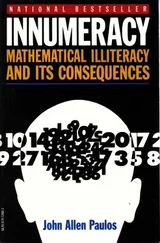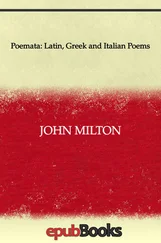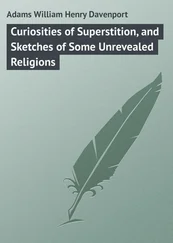John Gore - Astronomical Curiosities - Facts and Fallacies
Здесь есть возможность читать онлайн «John Gore - Astronomical Curiosities - Facts and Fallacies» — ознакомительный отрывок электронной книги совершенно бесплатно, а после прочтения отрывка купить полную версию. В некоторых случаях можно слушать аудио, скачать через торрент в формате fb2 и присутствует краткое содержание. Жанр: Физика, foreign_antique, foreign_prose, на английском языке. Описание произведения, (предисловие) а так же отзывы посетителей доступны на портале библиотеки ЛибКат.
- Название:Astronomical Curiosities: Facts and Fallacies
- Автор:
- Жанр:
- Год:неизвестен
- ISBN:нет данных
- Рейтинг книги:5 / 5. Голосов: 1
-
Избранное:Добавить в избранное
- Отзывы:
-
Ваша оценка:
- 100
- 1
- 2
- 3
- 4
- 5
Astronomical Curiosities: Facts and Fallacies: краткое содержание, описание и аннотация
Предлагаем к чтению аннотацию, описание, краткое содержание или предисловие (зависит от того, что написал сам автор книги «Astronomical Curiosities: Facts and Fallacies»). Если вы не нашли необходимую информацию о книге — напишите в комментариях, мы постараемся отыскать её.
Astronomical Curiosities: Facts and Fallacies — читать онлайн ознакомительный отрывок
Ниже представлен текст книги, разбитый по страницам. Система сохранения места последней прочитанной страницы, позволяет с удобством читать онлайн бесплатно книгу «Astronomical Curiosities: Facts and Fallacies», без необходимости каждый раз заново искать на чём Вы остановились. Поставьте закладку, и сможете в любой момент перейти на страницу, на которой закончили чтение.
Интервал:
Закладка:
Jupiter has been seen on several occasions apparently without his satellites; some being behind the disc, some eclipsed in his shadow, and some in transit across the disc. This phenomenon was seen by Galileo, March 15, 1611; by Molyneux, on November 12, 1681; by Sir William Herschel, May 23, 1802; by Wallis, April 15, 1826; by Greisbach, September 27, 1843; and by several observers on four occasions in the years 1867-1895. 142 142 Bulletin, Ast. Soc. de France , August, 1907.
The phenomenon again occurred on October 3, 1907, No. 1 being eclipsed and occulted, No. 2 in transit, No. 3 eclipsed, and No. 4 occulted. 143 143 Nature , August, 29 1907.
It was not, however, visible in Europe, but could have been seen in Asia and Oceania. [144] Nature , August, 29 1907.
The phenomenon will occur again on October 22, 1913. 144 144 Ibid. , March 7, 1907.
On the night of September 19, 1903, a star of magnitude 6½ was occulted by the disc of Jupiter. This curious and rare phenomenon was photographed by M. Lucien Rudaux at the Observatory of Donville, France. 145 145 Bulletin, Ast. Soc. de France , June, 1904.
The star was Lalande 45698 (= BAC 8129). 146 146 The Observatory , October, 1903, p. 392.
Prof. Barnard, using telescopes with apertures from 5 inches up to 36 inches (Lick), has failed to see a satellite through the planet’s limb (an observation which has been claimed by other astronomers). He says, “To my mind this has been due to either poor seeing, a poor telescope, or an excited observer.” 147 147 Astronomy and Astrophysics , 1894, p. 277.
He adds —
“I think it is high time that the astronomers reject the idea that the satellites of Jupiter can be seen through his limb at occultation. When the seeing is bad there is a spurious limb to Jupiter that well might give the appearance of transparency at the occultation of a satellite. But under first-class conditions the limb of Jupiter is perfectly opaque. It is quibbling and begging the question altogether to say the phenomenon of transparency may be a rare one and so have escaped my observations. Has any one said that the moon was transparent when a star has been seen projected on it when it ought to have been behind it?”
Prof. Barnard and Mr. Douglass have seen white polar caps on the third and fourth satellites of Jupiter. The former says they are “exactly like those on Mars.” “Both caps of the fourth satellite have been clearly distinguished, that at the north being sometimes exceptionally large, covering a surface equal to one-quarter or one-third of the diameter of the satellite.” 148 148 Nature , November 18, 1897.
This was confirmed on November 23, 1906, when Signor J. Comas Sola observed a brilliant white spot surrounded by a dark marking in the north polar region of the third satellite. There were other dark markings visible, and the satellite presented the appearance of a miniature of Mars. 149 149 Journal , B.A.A., January, 1907.
An eighth satellite of Jupiter has recently been discovered by Mr. Melotte at the Greenwich Observatory by means of photography. It moves in a retrograde direction round Jupiter in an orbit inclined about 30° to that of the planet. The period of revolution is about two years. The orbit is very eccentric, the eccentricity being about one-third, or greater than that of any other satellite of the solar system. When nearest to Jupiter it is about 9 millions of miles from the planet, and when farthest about 20 millions. 150 150 Journal , B.A.A., February, 1909, p. 161.
It has been suggested by Mr. George Forbes that this satellite may possibly be identical with the lost comet of Lexell which at its return in the year 1779 became entangled in Jupiter’s system, and has not been seen since. If this be the case, we should have the curious phenomenon of a comet revolving round a planet!
According to Humboldt the four bright satellites of Jupiter were seen almost simultaneously and quite independently by Simon Marius at Ausbach on December 29, 1609, and by Galileo at Padua on January 7, 1610. 151 151 Cosmos , vol. ii. p. 703.
The actual priority, therefore, seems to rest with Simon Marius, but the publication of the discovery was first made by Galileo in his Nuncius Siderius (1610). 152 152 Ibid.
Grant, however, in his History of Physical Astronomy , calls Simon Marius an “impudent pretender”! (p. 79).
M. Dupret at Algiers saw Jupiter with the naked eye on September 26, 1890, twenty minutes before sunset. 153 153 Denning, Telescopic Work for Starlight Evenings , p. 349.
Humboldt states that he saw Jupiter with the naked eye when the sun was from 18° to 20° above the horizon. 154 154 Cosmos , vol. iii. p. 75.
This was in the plains of South America near the sea-level.
CHAPTER IX
Saturn
To show the advantages of large telescopes over small ones, Mr. C. Roberts says that “with the 25-inch refractor of the Cambridge Observatory the view of the planet Saturn is indescribably glorious; everything I had ever seen before was visible at a glance, and an enormous amount of detail that I had never even glimpsed before, after a few minutes’ observation.” 155 155 Journal , B.A.A., June, 1896.
Chacornac found that the illumination of Saturn’s disc is the reverse of that of Jupiter, the edges of Saturn being brighter than the centre of the disc, while in the case of Jupiter – as in that of the sun – the edges are fainter than the centre. 156 156 Celestial Objects , vol. i. p. 191.
According to Mr. Denning, Saturn bears satisfactorily “greater magnifying power than either Mars or Jupiter.” 157 157 Nature , May 30, 1901.
At an occultation of Saturn by the moon, which occurred on June 13, 1900, M. M. Honorat noticed the great contrast between the slightly yellowish colour of the moon and the greenish tint of the planet. 158 158 Bulletin, Ast. Soc. de France , August, 1900.
In the year 1892, when the rings of Saturn had nearly disappeared, Prof. L. W. Underwood, of the Underwood Observatory, Appleton, Wisconsin (U.S.A.), saw one of Saturn’s satellites (Titan) apparently moving along the needlelike appendage to the planet presented by the rings. “The apparent diameter of the satellite so far exceeded the apparent thickness of the ring that it gave the appearance of a beautiful golden bead moving very slowly along a fine golden thread.” 159 159 Astronomy and Astrophysics , 1892.
In 1907, when the rings of Saturn became invisible in ordinary telescopes, Professor Campbell, observing with the great Lick telescope, noticed “prominent bright knots, visible … in Saturn’s rings. The knots were symmetrically placed, two being to the east and two to the west.” This was confirmed by Mr. Lowell, who says, “Condensations in Saturn’s rings confirmed here and measured repeatedly. Symmetric and permanent.” This phenomenon was previously seen by Bond in the years 1847-56. Measures of these light spots made by Prof. Barnard with the 40-inch Yerkes telescope show that the outer one corresponded in position with the outer edge of the middle ring close to the Cassini division, and the inner condensation, curious to say, seemed to coincide in position with the “crape ring.” Prof. Barnard thinks that the thickness of the rings “must be greatly under 100 miles, and probably less than 50 miles,” and he says —
“The important fact clearly brought out at this apparition of Saturn is that the bright rings are not opaque to the light of the sun – and this is really what we should expect from the nature of their constitution as shown by the theory of Clerk Maxwell, and the spectroscopic results of Keeler.” 160 160 Astrophysical Journal , January, 1908, p. 35.
Интервал:
Закладка:
Похожие книги на «Astronomical Curiosities: Facts and Fallacies»
Представляем Вашему вниманию похожие книги на «Astronomical Curiosities: Facts and Fallacies» списком для выбора. Мы отобрали схожую по названию и смыслу литературу в надежде предоставить читателям больше вариантов отыскать новые, интересные, ещё непрочитанные произведения.
Обсуждение, отзывы о книге «Astronomical Curiosities: Facts and Fallacies» и просто собственные мнения читателей. Оставьте ваши комментарии, напишите, что Вы думаете о произведении, его смысле или главных героях. Укажите что конкретно понравилось, а что нет, и почему Вы так считаете.











